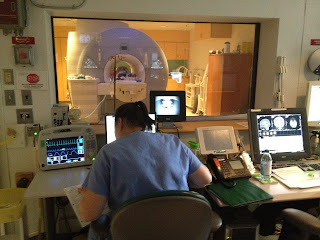Other Scans for AAA: MRI
What is an MRI and why do I need one?
MRI (magnetic resonance imaging) is another imaging procedure that you might encounter with an AAA. It uses magnetic fields to obtain a clear picture of internal organs. It is a particularly effective exam as it allows the aorta to be imaged without the use of contrast agents or ionising radiation. It is used as it often offers better imaging of the aorta branch vessels than other exams and may also be used when it is unadvisable for the patient to receive ionised contrast used in CT.
 |
| MRI control room (Source: https://basicsofpediatricanesthesia.com/30-mri-control-room/ ) |
How does MRI imaging work?
An MRI uses a magnetic field and a radio-frequency current to stimulate the protons in your body, causing them to strain against the pull of the magnetic field. MRI sensors create images by detecting the energy released as the protons in your body realign with the magnetic field after the radio-frequency current is turned off. This allows your healthcare practitioner to create an anatomical image of your abdominal aortic aneurysm.
MRI Patient Preparation and What to Expect on the Day:
There is no need to fast or stop taking your medication in preparation for this examination. You will be asked to change into a hospital gown. You may be administered a contrast agent; which is a dye that makes certain body parts more visible in the image. In the room, the radiographer will ask you to lie down on a table that slides into a tube. The process is monitored from another room so that the computer is not affected by the magnetic field.
There are not many precautions post-scanning for MRI. You can go back home as soon as you are done. However; if you have been sedated, you should be accompanied by someone for the next 24 hours. Also, for your safety, you are advised to not drink alcohol, drive or operate machinery in this period. In addition, if you were administered a contrast agent, you should drink lots of water.
Before an MRI scan, you may be asked to complete a questionnaire about any metal parts in your body. This is because MRI has a high magnetic field, and also any artefacts will deform the final image.
There is no need for you to worry about being alone; you can communicate with the radiographer via a microphone. Also, MRI scans are completely painless. You must hold still for the duration of the scan so that the image produced is not blurry. The scan can last from 15-90 minutes. There are two drawbacks to MRI; firstly, the MRI scan takes place in a is a tight space which may be uncomfortable and claustrophobic, and secondly, the machine can be noisy, but don’t worry; earplugs will be provided! If this particularly worries you, you should discuss it with your healthcare practitioner who will do their best to accommodate your wishes.
The results of your MRI will be sent to your referring doctor who will discuss the results with you later.
 |
| An MRI image of AAA ( Adapted from: https://www.ncbi.nlm.nih.gov/ |


Comments
Post a Comment